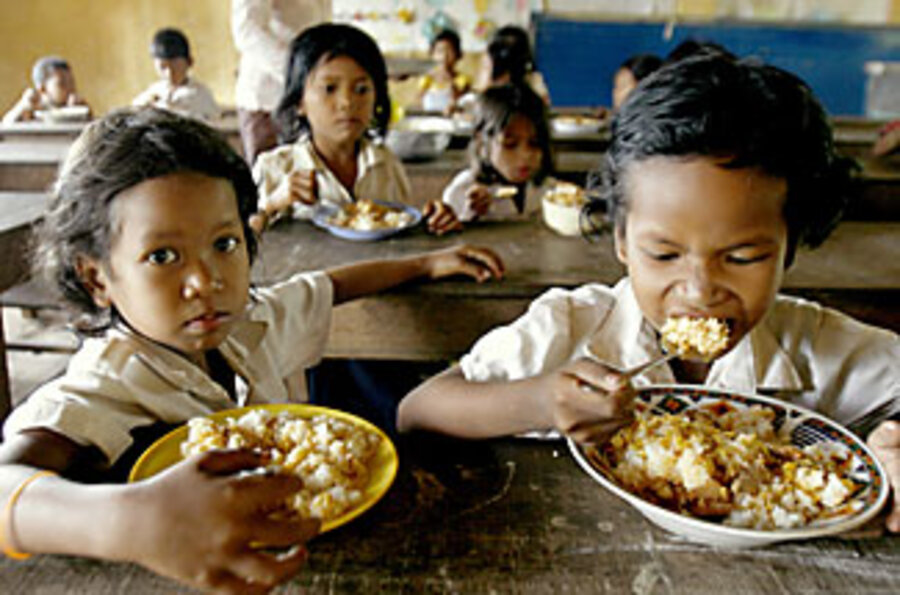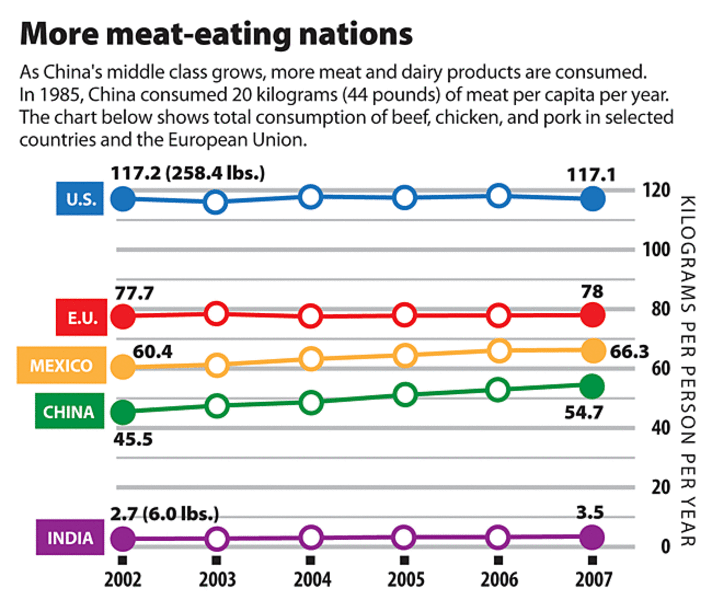Briefing: Lessons from past food crises
Loading...
A burgeoning population. Soaring energy costs. Rising demand for meat. A catastrophic harvest. A sudden run on the grain market – and an 80 percent surge in food prices in three years.
A brief run-down of the current world food crisis? Yes, but it also applies to the early 1970s – the last time the collective cupboard was bare. Despite similarities, today's food price shock also has some striking features which sets it apart from past crises.
As world leaders gather in Rome Tuesday for a three-day United Nations conference on what steps to take to address the international food crisis, they might study what lessons can be learned from the recent pages of history.
How unusual is this food crisis?
The current situation is hardly unprecedented. The 1972 alarm, triggered by a hungry Soviet Union seeking to compensate for failed grain harvests, had brutal knock-on effects in East Africa and the Asian subcontinent. Farm prices didn't start falling until 1975, once Washington and Moscow reached an agreement on grain trade. The deal sought to regulate Soviet grain purchases and calm markets by removing any sudden spikes in demand that would drain stockpiles. The episode left a clear lesson: transparency and regular trading between big market players can prevent price spikes.
Prior to 1972, anyone who has read John Steinbeck's early works will know about the privations of the 1930s. This was the most lasting food shock of the past century. It started during the Great Depression and was extended by World War II, as trading between nations broke down.
But Prof. Tim Lang, a prominent British food industry expert, says it was this shock that produced the modern agronomic era, where science took aim at boosting farm productivity.
Food prices also spiked in the late 1980s, and again in the mid 1990s after a drought crimped US grain supplies. On both occasions, markets settled down as farmers responded by planting more crops.
How does this crisis compare?
It's similar – and yet different. The World Food Program highlights four principal drivers. Two are familiar: the rise in oil prices which affect the entire value chain of food production, and weather-related events (bad harvests, particularly in Australia). Two are new: the diversion of crops for use in biofuels, and the rising prosperity of the world's two most populous nations, China and India.
"We have probably close to 4 billion people wanting to move up the food chain, consuming more meat, milk, and maize – and that takes a lot of grain," says Lester Brown, who heads the Earth Policy Institute in Washington. Data from the Australian Central Bank finds that the Chinese ate 20 kilograms (44 pounds) of meat per capita in 1985. Today, it's 54 kilograms (119 pounds) of meat per year (see chart).
"We have also seen an enormous growth in the last couple years in the use of grain to produce ethanol fuel in the US," Mr. Brown adds. The annual growth in world grain consumption, he says, has shot up from around 20 million tons a year from 1990-2005 to more than 40 million tons in the past two years. He blames much of the rise on a diversion of corn to ethanol distilleries.
"Biofuel demand is the largest source of new demand in decades and a strong factor underpinning the upward shift in agricultural commodity prices," said a report by the UN's Food and Agriculture Organization (FAO) this past week.
But US Agriculture Secretary Edward Schafer told reporters Thursday that biofuel production has only pushed up global food prices by 2 or 3 percent. He added that biofuels had cut consumption of oil by a million barrels a day.
What is the impact of this crisis?
Brown argues that the effects of this crisis are very different from the 1970s. Then, he says, the impact was geographical with famine in the African Sahel and Bangladesh. Today, he says, hunger no longer hits just a few specific countries, but hits the lowest income groups around the world.
Still, as incomes rise globally, fewer may actually experience hunger. In many parts of the world, food takes a far smaller percentage of family budgets than it did a generation ago. In rich countries, the FAO says, it has gone from around 30 percent in the 1970s to less than 10 percent of the budget today. In middle-income countries, food costs have also fallen proportionally, though they still take up a sizable chunk of the weekly paycheck (30-40 percent). So the public response this time around has been more anger than hunger.
But in poorer countries, the pinch is felt. "When you look at food as a percentage of the consumer price index in poor countries, it's [still] more than 50 to 60 percent of household spending," says Abdolreza Abbassian, secretary of intergovernmental group on grains for the UN's FAO.
The number of people considered "food insecure" (i.e. who go hungry) is starting to rise back above 850 million, after having fallen consistently for decades to 800 million, according to the FAO.
What can be learned from the resolution to previous crises?
Both the 1930s and 1970s crises generated blue-sky thinking about how to feed the world. The 1970s gave rise to a boost in research and development and the green revolution. "The analogy today would be [to spur research in] GM (genetically modified food)," says Mr. Abbassian. "One of the lessons is to look at research in food technology and whether this has room to improve. People have to look at agriculture from scratch. Research has been neglected for so long."
What institutional responses have been helpful?
During this crisis – like those in the past – governments have initially acted to either protect their consumers or their producers, with mixed results. Some like Mauritania and Egypt are now spending money to increase food assistance to the poor. Cash handouts are better than food handouts, nongovernmental organizations say.
Two dozen countries have reduced import duties in an effort to make food cheaper for their citizens. Others are trying to boost local infrastructure to help local producers.
Longer term, Oxfam spokesperson Amy Barry calls for basic measures like better storage facilities, roads, and ports to ensure that produce in developing countries by smaller producers competes on a level playing field. The World Bank has noted that better transport links in Congo helped to brake accelerating food prices in 2006.
What institutional responses have not been helpful?
Predictably, many governments have rushed to restrict exports to ensure that their own people don't go hungry while their produce is being shipped overseas. But national hoarding, history tells us, tends to perpetuate the global shortage, pushing up prices. "It's more a result of panic reaction rather than rational thinking," says Abbassian. "Export restrictions – taxes and bans – that we have seen starting with Russia, Ukraine, and Argentina, prolong the situation."
After initiating export bans in March, Cambodia and Pakistan recently lifted their bans on exporting rice – and prices have started to ease.
Longer term, some analysts say the subsidies and tariffs that Europe and the US have used to protect their farmers must be reduced. Some experts note that the Nixon administration boosted US subsidies (instead of loans) to farmers as the "solution" to the 1970s grain crisis.
Today, "France is arguing that subsidies are even more necessary than before" [to ensure food security and build up domestic stockpiles], says Prof. Wyn Grant, a food and agricultural policy expert at Warwick University in England. "But these are blanket, nontargeted subsidies which have little to do with what is produced. The higher tariff protection also makes it very difficult for third world producers to break into world agriculture."
For example, the US charges a 54-cents-per-gallon import tariff on Brazil's sugar-cane ethanol, which is cheaper to produce than corn ethanol. If the tariffs were lifted, US Federal Reserve Chairman Ben Bernanke argued in February, it would ease demand (and lower prices) for corn. He saw it as a way to fight inflation.
What needs to happen in the long run to feed the world?
UN Secretary-General Ban Ki Moon noted recently that the world had consumed more than it had produced in the past three years, but this need not provoke alarm. It didn't produce as much because stockpiles were high, prices were low, and farmers had little incentive to plant. With that situation reversed, supply will increase.
The FAO is already predicting a 2.3 percent rise in rice output this year. Abbassian says production for most cereals will be much higher in 2008 than in 2007. The World Bank says high prices will persist through 2009, before declining slightly "as supply and demand respond to high prices."
Other are skeptical, however, that this crisis will be buried under copious volumes of bumper grain harvests.
Brown says the first step is "to reduce the amount of US grain going into ethanol. In an effort to reduce our oil insecurity we have increased global food insecurity big time," he laments. He adds that both population growth and climate change will have to be stabilized to mitigate the affect of future food price shocks.
And then there is water. "We need to launch an international effort to raise water productivity in much the same way that in the 1950s we concentrated on raising land productivity," Brown says.
Professor Grant calls for greater public funding for research into food technology. "Advances made by multinational companies [alone] are not trusted," he says, and governments need to step in, particularly in the area of genetically modified foods, which could promise greater yields.
Ms. Barry says that global trade rules need reforming to help developing countries maintain a range of tools that will benefit domestic farmers. "Decades of trade liberalization have removed trade policy tools from the hands of developing country governments, which essentially means they are in a more vulnerable position," she says.
And Lang agrees with Brown that water is a crucial factor: scarce, critical to production, yet woefully underpriced. In fact, he ventures a counterintuitive thought: "Our food prices are too cheap," he says, the current situation notwithstanding. "They do not include the full cost of production."
The current model that emerged from the dark days of the 1930s and '40s, he says, has led in many parts of the world to overproduction and overconsumption. As a result, he says, we're dealing with obesity, health problems, water stresses, environmental degradation, and contamination.
It's time, he says for a new agricultural model, based on different standards of excellence: nutritional content, carbon footprint, water use, land use, biodiversity, animal welfare, social justice, and locally grown produce. "I can get green beans at Tesco [a British grocery chain] from Kenya, but each one has four litres of 'embedded water' from a water-stressed country," he says. "That is a disaster. I think that water should stay in Kenya."






